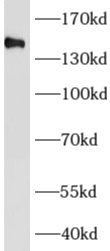Products
AFF4 antibody
| Synonyms: | AF4/FMR2 family member 4|ALL1-fused gene from chromosome 5q31 protein (Protein AF-5q31)|Major CDK9 elongation factor-associated protein|AFF4|AF5Q31|MCEF antibody | ||
| Catalogue No.: | FNab00197 | Reactivity: | Human, Mouse, Rat |
| Host: | Rabbit | Tested Application: | ELISA, WB, IP |
| Clonality: | polyclonal | Isotype: | IgG |
| Size | Price |
|---|---|
| 100µg | Inquiry |
- SPECIFICATIONS
- FIGURES
- CONDITIONS
- FAQS
- Product Name
- AFF4 antibody
- Catalogue No.
- FNab00197
- Size
- 100μg
- Form
- liquid
- Purification
- Immunogen affinity purified
- Purity
- ≥95% as determined by SDS-PAGE
- Clonality
- polyclonal
- Isotype
- IgG
- Storage
- PBS with 0.02% sodium azide and 50% glycerol pH 7.3, -20℃ for 12 months(Avoid repeated freeze / thaw cycles.)
- Immunogen
- AF4/FMR2 family, member 4
- Alternative Names
- AF4/FMR2 family member 4|ALL1-fused gene from chromosome 5q31 protein (Protein AF-5q31)|Major CDK9 elongation factor-associated protein|AFF4|AF5Q31|MCEF antibody
- UniProt ID
- Q9UHB7
- Observed MW
- 150 kDa
- Tested Applications
- ELISA, WB, IP
- Recommended dilution
- WB: 1:200-1:2000; IP: 1:200-1:1000
 L02 cells were subjected to SDS PAGE followed by western blot with FNab00197(AFF4 antibody) at dilution of 1:500
L02 cells were subjected to SDS PAGE followed by western blot with FNab00197(AFF4 antibody) at dilution of 1:500
 IP Result of anti-AFF4 (IP:FNab00197, 4ug; Detection:FNab00197 1:300) with HepG2 cells lysate 3200ug.
IP Result of anti-AFF4 (IP:FNab00197, 4ug; Detection:FNab00197 1:300) with HepG2 cells lysate 3200ug.
- Background
- Key component of the super elongation complex(SEC), a complex required to increase the catalytic rate of RNA polymerase II transcription by suppressing transient pausing by the polymerase at multiple sites along the DNA. In the SEC complex, AFF4 acts as a central scaffold that recruits other factors through direct interactions with ELL proteins(ELL, ELL2 or ELL3) and the P-TEFb complex. In case of infection by HIV-1 virus, the SEC complex is recruited by the viral Tat protein to stimulate viral gene expression.
How many times can antibodies be recycled?
First, usually it's not suggested to recycle antibodies. After use, buffer system of antibodies has changed. The storage condition of recycled antibodies for different customers also varies. Thus, the performance efficiency of recycled antibodies can’t be guaranteed. Besides, FineTest ever conducted the antibody recycling assay. Assay results show recycling times of different antibodies also varies. Usually, higher antibody titer allows more repeated use. Customers can determine based on experimental requirements.
Notes: After incubation, we recycle rest antibodies to centrifuge tube and store at 4℃. High titer antibodies can be stored for a minimum of one week. Reuse about three times.
What are components of FineTest antibody buffer?
Components of FineTest antibody buffer are usually PBS with proclin300 or sodium azide, BSA, 50% glycerol. Common preservative is proclin300 or sodium azide, which is widely applied in the lab and industry.
How about the storage temperature and duration of FineTest antibodies?
Most antibodies are stored at -20℃. Directly-labeled flow cytometry antibodies should be stored at 2 - 8℃. The shelf life is one year. If after sales issues for purchased antibodies appear, return or replacement is available. Usually, antibodies can be still used after the one-year warranty. We can offer technical support services.
Is dilution required for FineTest antibodies? What’s the dilute solution?
Directly-labeled flow cytometry antibodies are ready-to-use without dilution. Other antibodies are usually concentrated. Follow the dilution ratio suggested in the manual. Dilute solution for different experiments also varies. Common antibody dilution buffers are acceptable(e.g. PBST, TBST, antibody blocking buffer).
How to retrieve antibodies for immunohistochemistry?
Common retrieval buffers: Tris-EDTA Buffer(pH 9.0); Citrate Buffer(pH 6.0)
Heat induced antibody retrieval:
Method 1: Water-bath heating: Put the beaker with retrieval buffer and slide in the boiling water bath. Keep the boiling state for 15min. Naturally cool to room temperature;
Method 2: Microwave retrieval: Put the beaker with retrieval buffer and slide in the microwave oven. Heat at high power for 5min, Switch OFF for 3min, Heat at medium power for 5min. Naturally cool to room temperature.
How to choose secondary antibodies?
(1) Secondary antibodies react with primary antibodies. Thus, secondary antibodies should be against host species of primary antibodies. E.g. If the primary antibody is derived from rabbit, the relevant secondary antibody should be against rabbit. E.g. goat anti rabbit or donkey anti rabbit.
(2) Choose secondary antibody conjugates according to the experimental type, e.g. ELISA, WB, IHC etc. Common enzyme conjugated secondary antibodies are labelled by HRP, AP etc. Fluorescin or dye labelled secondary antibodies are applied in immunofluorescence and flow cytometry(e.g. FITC, Cy3).
